
Wine Culture and Information since 2002 - Volume 22
 Wine Culture and Information since 2002 - Volume 22 |
|
Issue 173, May 2018 |
Contents |
|
|
Past, Present and Future of Wine |
|
In the beginning, it seems, there was some fermented grape juice, who knows how, that our very distant ancestors found pleasant to drink and then learned how to transform it into a foundational drink of countless cultures. We cannot imagine how man has exactly managed to “dominate” fermentation and the biological and chemical phenomena leading to wine – or vinegar – we however know for sure history has given us significant findings on how and to what extent this beverage has been important for man. It is hard to imagine what those primitive wines were like, we can however easily think the result was certainly far, probably very far, from our concept of wine and taste. It is also easy to think, even by reading the chronicles of remote times, the wines produced at the dawn of civilization were pretty robust, probably dense and sweet, more or less acidic, that is tending towards vinegar. We can think, for example, about the Greek custom of diluting wine with water – also seawater, that is with salt – before serving it during their symposia. A practice imposed, perhaps, also by the need of making the wines of those times more pleasant as well as for ritual reasons. On this regard, I like to recall a drink that was once very popular among the people in Umbria – and all over central Italy – capable of giving relief and refreshment to the farmers during the hard and sultry work in the fields: acetello. It is simply water and vinegar – a little part or it – which must be drunk strictly cool and unequivocally reminiscent of posca of the ancient Romans, a clearly evident daughter of the ancient custom of blending wine with water. A decidedly thirst quenching beverage, it was also the remedy of our grandmothers to relieve the summer heat of their hothead and lively nephews, including myself. Today, it is very likely a poor and simple drink such as acetello, does not meet the favor of modern taste, just like the wines of the past. However, I admit that, especially in summer, I hardly find better thirst quenchers and refreshing drinks than acetello, including a simple wine – white or red, it makes no difference – diluted with water, preferably carbonated water. A factor that has always characterized wine – in the past, present and certainly future – is trade. Proofs about the sale and trading of wine, in fact, have come to us from remote times. Anyone who wrote about wine in the past has inevitably focused on the commercial aspect as well as how important it was for the civilizations which preceded us. Too easy to assert the trading of wine is the primary foundation of its production. Wine producers undeniably have costs, certainly animated by sincere passion and commitment, their aim is clearly and legitimately having a profit from their job. We can consider wine in terms of romantic, traditional, cultural and emotional aspects, but it is clearly legitimate for those who make to do that also in order to get a financial profit. Trade and profit – undeniably – are also determined by fads about wine that, over the years, come to existence, grow up and then disappear. On this regard, it is worth mentioning the fad of white wines which was so common in Italy about twenty years ago, a fad which determined a significant increase in the sales of this style of wine at the expense of red wines. Any winery – at that time – was practically forced to make at least one white wine in order to maintain “market shares”. In the tables of restaurants and pizzerias, it was always and inevitably found a bottle of white wine, often produced with Pinot Gris. When this fad was over, there has been the clear and unstoppable return of red wines, often with a strong wooden character due to the aging in barrique, a magic capable of transforming any wine, especially mediocre ones, into heavenly nectars. In Italy, those wines were defined as barricati – also proudly emphasized on the label as a guarantee of superior quality, very presumed and supposed, to tell the truth – wines that seemed more to be made in a carpentry than in a winery. Today we are witnessing a very drastic change of trend compared to those times, with wineries that – to follow the fads of the moment, in order to make sure they get a legitimate profit from their work – adapt the production to the will of more or less questionable fads. Organic, biodynamic, natural, artisanal, without added sulfites, with indigenous yeasts, easy, young, environment-friendly, immediate, simple and “whatever wine you want provided you buy it”. From a commercial point of view, this is understandable: fads, in addition to offering an opportunity for profit, are also a way of diversifying production, in order meet a greater number of customers. In my opinion, however, all these fads do nothing more than determining a deleterious phenomenon for the quality and dignity of wine: standardization. The tendency of satisfying a certain demand, in particular a dominating one, inevitably leads to the standardization of a product, while making it look or taste like – for purely commercial reasons – to the most successful wines. All similar, all the same, most of the times trivial. It is now many years I am noticing a boring standardization of wine, something which can be found in any style or wine making philosophy. Wines belonging to a certain style or school of thought inevitably tend to be all the same and in an embarrassing way, even – and perhaps especially – when man is convinced of letting nature do its own way. In recent times, moreover, certain simple and immediate wines have become more and more popular, explicitly made for young people, that is those who will be the men of the future. Wines that should be consumed in informal and thoughtless moments, wines intentionally trivial from an organoleptic point of view, often having no character nor personality. This could make us think young people, when they have wine, do not need to care about what it is being poured in their glasses: the important thing is to have something to be drunk mindlessly and for the fun of it. Easy, as it is now commonly said in Italy among those who can barely speak Italian, even less a decent English, however giving them the idea of being “busy” and “modern”. Simple, immediate and soulless, a wine giving no emotion, which is forgotten even before it is poured in the glass, which is easily confused in the middle of nothingness. If it is a wine intended for young people, therefore – in theory – a product also having a formative and educational role, is this the future we want to make for wine and only for supporting the superficiality of a fad? Antonello Biancalana
|
||||
Contrasts of Arneis and Muscat of AlexandriaThis month we are going to compare two white berried grapes, distant in every regard, both from an organoleptic, from colors to aromas, and geopraphic point of view |
|
The comparison of an aromatic variety with a non-aromatic one is always useful for the understanding of the characteristics determining the belonging to the respective categories. Clear and evident differences, as to make the comparison seem useless, indeed very interesting for the understanding of the influence of the so-called primary aromas in the profile of wine. This exercise becomes more useful and important in case the grape to be compared is very distant from the aromatic variety. In this sense, Arneis grape – glorious white berried variety from Piedmont, in particular from Roero – perfectly contrasts the primary aromatic characteristics of Muscat of Alexandria. Piedmont and Sicily – regions of reference for these two grapes – will in fact be compared in the glasses of the tasting by contrast of this month, a comparison that – of course – is not exclusively oriented to the study of the aromas of grapes. Arneis and Muscat of Alexandria – in Sicily better known as Zibibbo, probably from the Arab zabīb, meaning raisin – are two varieties having distinct and distant history and identity, capable, in both cases, of making wines with good personality. In addition to the distance of their respective geographical location where they are primarily cultivated in, Arneis and Muscat of Alexandria are characterized by the sensorial profile of their wines, decidedly different in every aspect. The two varieties strongly characterizes their respective and main areas of cultivation. Arneis is in fact the protagonist of Roero white wines, moreover it is also found in other wine areas of Piedmont. Muscat of Alexandria is the undisputed protagonist in sweet wines of Sicily – in particular those made in Pantelleria island – where it is being cultivated since immemorial times. Zibibbo – this is how it is known in Sicily – has proven since a very long time its undisputed quality in creating charming and elegant wines, not only in sweet styles from dry grapes, but also in the vinification of dry wines.
|
|
Arneis is the main protagonist of the white wines of the Roero area and recognized as Denominazione d'Origine Controllata e Garantita (DOCG) both for red wines and for those produced with this grape. The origins of Arneis are not completely clear, however it is believed it is original from the Roero area, the territory in which this variety is known to be present since many centuries. Not everyone, it should be said, believes Roero is the land of origin of Arneis, however, they consider Piedmont as its territory of origin. Some support the idea Arneis originates in Chieri – in the province of Turin – associating it with the ancient variety Ranaysii, of which there are historical information since 1400s. Moreover, dated back to that period, there are mentions to this variety as Reneysium (also known as Arneiso or Reneiso, identified in the toponym of Bric Renesio) in the territory of Canale, in province of Cuneo. For some the origin of the name – also in this case disputed and debated – is from these two ancient varieties. For others, the origin of the name Arneis comes from the Piedmontese dialect, a term used for indicating a bizarre or grumpy person or thing. A special mention should be made for one of the many names by which this grape is known in Piedmont. In the past it was also known with the name of Nebbiolo Bianco (White Nebbiolo), however it should be noted Arneis has no connection or similarity to the famous Piedmontese red grape, not even of genetic nature. Grapes with a high sugar content and moderate acidity, in past times Arneis received considerable interest from producers up to the World War II period, when it will be witnessed a notable change in favor of Nebbiolo, progressively disappearing from the vineyards of Piedmont. The revaluation of Arneis is thanks to the initiative of some producers who resumed the cultivation of this grape with modern viticultural and wine making criteria. A quality path which will lead the wines produced with Arneis in the Roero area to obtain the DOCG status.
|
||||
|
Muscat of Alexandria is strongly and historically associated to Sicily and, in particular, to the sweet and fortified wines produced with this dried grape. The fame of the wines made with this variety – known in Sicily as Zibibbo – is mainly because of those produced in Pantelleria island, where Muscat of Alexandria reaches levels of absolute excellence. It is believed Zibibbo is one of the oldest known varieties, in particular, it is believed this grape has come to our days in its original form without having undergone any genetic modification or mutation. The origin of Muscat of Alexandria is probably to be traced back to North Africa, in particular from the city of Alexandria in Egypt, the place from which it presumably takes its name. More specifically, it is believed the wines of the ancient Egyptians were produced with this variety. It should also be noted that, at that time, Muscat of Alexandria was used – after having been dried – as a fruit to be eaten. The cultivation and use of Muscat of Alexandria in the production of the wines of the past is widely documented, widespread throughout the western basin of the Mediterranean and in North Africa. In Sicily it was introduced by the Phoenicians, which also introduced some viticultural techniques, establishing with this island a very solid bond, so much that, in Italy, Muscat of Alexandria is practically present in this region only. This variety is also cultivated in other wine-growing areas of the world, including California and Australia, as well as many of the countries bordering the Mediterranean. In Sicily, Muscat of Alexandria is mainly used for the production of sweet wines from dried grapes, often with the addition of brandy – that is made as a fortified wine – however, the results obtained from the vinification in dry is interesting as well. Wines produced with Muscat of Alexandria, regardless of the style, are distinguished for the distinct aromatic qualities directly recalling grape juice.
|
As usual, the wines we will put in contrast in our tasting are produced with the respective varieties alone and vinified or aged in inert containers, that is steel or cement tanks. As for Arneis, our choice is in favor of Roero Arneis – a Denominazione d'Origine Controllata e Garantita wine – which production disciplinary provides for a minumum of 95% of this variety. We will therefore make sure – despite the minimum legal quota of 5% represented by other grapes may seems irrelevant – the wine is exclusively produced with Arneis. As for Muscat of Alexandria, we will choose a dry wine, therefore produced from ripe and non dried grapes, that is a non-sweet wine. In this case the choice becomes more difficult as most of the wine made from Zibibbo is produced with dried grapes, therefore sweet. We will choose, in any case, a dry Muscat of Alexandria produced in the eastern part of Sicily. Both wines belong to the most recent vintage, vinified in inert containers and served in tasting glasses at a temperature of 10 °C (50 °F). It's time to start our tasting by contrast, we therefore pour Roero Arneis and Muscat of Alexandria in their respective glasses in order to proceed with the evaluation of the appearance in both wines. The first wine we will evaluate is Roero Arneis. Let's tilt the glass over a white surface and observe the base of the wine, from which we can see a bright straw yellow color and a high transparency. Let's now observe the edge of the wine, towards the opening of the glass, therefore evaluating nuances. We can observe a greenish yellow color, also proving its young age. Let's move on to the glass of Muscat of Alexandria and tilt it over the white surface. At the base of the wine we notice a brilliant golden yellow color, also in this case with a very high transparency. The nuance of the wine, observed towards the opening of the glass, confirms a golden yellow hue. If it is true differences in appearance between the two wines are evident, they become even distant in their respective olfactory profiles. In particular, the fact they belong to two different categories of grapes, it is a factor that more than others will determine the sensorial difference between Arneis and Muscat of Alexandria. The Sicilian variety, in fact, belongs to the category of the so-called aromatic varieties, that is grapes capable of making wines characterized by the intense aroma of grape juice. A quality that, when compared to a wine produced with non-aromatic grapes, represents a remarkable element of contrast. This does not mean, of course, wines produced with Arneis, as well as with any non-aromatic variety, do not express aromas, however the comparison with an aromatic variety puts the two grapes in very distant sides. In fact, it must be said wines made from non-aromatic varieties are characterized by secondary aromas only, that is given or, better to say, revealed by alcoholic fermentation and possibly tertiary aromas, that is given by time. Let's resume our tasting by contrast and proceed with the analysis of the olfactory profiles of Roero Arneis and Muscat of Alexandria, starting from the Piedmontese wine. By holding the glass in vertical position and, without swirling, let's do the first smell in order to evaluate the opening aromas of the wine. From the glass can be perceived clean and intense aromas of pear, peach and hazelnut, the latter considered one of the identifying aromas of Arneis. After having swirled the glass, an operation favoring the development of the other aromas, the olfactory profile of Arneis is completed with apple, plum, hawthorn, citrus fruits and broom, as well as hints of exotic fruit, in particular pineapple. Let's now evaluate the opening of Muscat of Alexandria: from the glass can be perceived, first of all, the intense aroma of grape – an exclusive characteristic of aromatic varieties – followed by peach, apricot and apple. After having swirled the glass, the profile of the Sicilian wine is completed with citrus fruits, almond, yellow rose and sage. After having evaluated the aromas of the two wines, let's proceed with the analysis of the gustatory profiles of Arneis and Muscat of Alexandria, in which differences are evidently distant. Just like the previous phases, we will start the evaluation from Roero Arneis, therefore taking a sip of this wine in order to evaluate its attack. In the mouth can be perceived a pleasant crispness and a good structure, as well as the warm sensation of alcohol. In the mouth are perceived flavors of pear, plum and apple, therefore confirming a good correspondence to the nose. The attack of the Muscat of Alexandria is characterized by greater roundness, supported by a pleasing acidity, and also in this case the sensation of alcohol is well perceptible. In the mouth can be clearly perceived the taste of grape – specifically, grape juice – as well as apricots and peach, followed by a pleasant hint of almond, also in this case expressing a good correspondence to the nose. The last phase of our tasting by contrast is about the evaluation of the final sensations the wines leave in the mouth, in particular taste-olfactory persistence. The finish of Roero Arneis is persistent, leaving in the mouth a pleasing crispness combined to a good structure and the typical pseudo-burning sensation of alcohol. We can perceive flavors of pear, plum and apple, as well as hints of hazelnut. The finish of Muscat of Alexandria is equally persistent, leaving in the mouth, compared to the Arneis, a sensation of greater roundness combined to the burning stimulus of alcohol, well balanced by a proper acidity. In the mouth can be clearly perceived flavors of grape juice, followed by apricot and peach. Let's now put the two glasses side by side and let's compare again both the olfactory and taste profiles of the two wines: differences are evident, in particular the contrast between the aromas of the Arneis and the aromatic character of Muscat of Alexandria.
|
||||||||
Wines of the Month |
|
|
|
Score legend Prices are to be considered as indicative. Prices may vary according to the country or the shop where wines are bought |
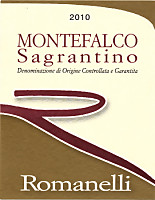
|
|
Montefalco Sagrantino 2010 |
|
| Romanelli (Umbria, Italy) | |
 Sagrantino Sagrantino | |
| Price: € 28.00 | Score: |
 Intense ruby red and nuances of garnet red, little transparency. Intense ruby red and nuances of garnet red, little transparency. Intense, clean, pleasing, refined and elegant, starts with hints of
blackberry, black cherry and plum followed by aromas of dried violet,
blueberry, chocolate, tobacco, vanilla, cinnamon, mace, pink pepper and
menthol. Intense, clean, pleasing, refined and elegant, starts with hints of
blackberry, black cherry and plum followed by aromas of dried violet,
blueberry, chocolate, tobacco, vanilla, cinnamon, mace, pink pepper and
menthol.
 Tannic attack and however balanced by alcohol, full body, intense
flavors, pleasing roundness. Tannic attack and however balanced by alcohol, full body, intense
flavors, pleasing roundness.
 Persistent finish with flavors of blackberry, plum and black cherry. Persistent finish with flavors of blackberry, plum and black cherry. 18 months in cask and barrique, at least 12 months in bottle. 18 months in cask and barrique, at least 12 months in bottle. |
|
 Game, Roasted meat, Stewed and braised meat, Hard cheese Game, Roasted meat, Stewed and braised meat, Hard cheese |
|
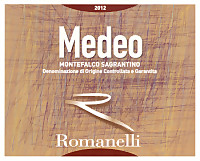
|
|
Montefalco Sagrantino Medeo 2012 |
|
| Romanelli (Umbria, Italy) | |
 Sagrantino Sagrantino | |
| Price: € 55.00 | Score: |
 Intense ruby red and nuances of garnet red, little transparency. Intense ruby red and nuances of garnet red, little transparency. Intense, clean, pleasing, refined and elegant, starts with hints of
blackberry, plum and dried violet followed by aromas of black cherry,
blueberry, chocolate, tobacco, cinnamon, tamarind, carob, walnut husk,
vanilla and menthol. Intense, clean, pleasing, refined and elegant, starts with hints of
blackberry, plum and dried violet followed by aromas of black cherry,
blueberry, chocolate, tobacco, cinnamon, tamarind, carob, walnut husk,
vanilla and menthol.
 Tannic attack and however balanced by alcohol, full body, intense
flavors, pleasing roundness. Tannic attack and however balanced by alcohol, full body, intense
flavors, pleasing roundness.
 Persistent finish with flavors of blackberry, plum and black cherry. Persistent finish with flavors of blackberry, plum and black cherry. 24 months in barrique, 18 months in bottle. 24 months in barrique, 18 months in bottle. |
|
 Game, Stewed and braised meat, Roasted meat, Hard cheese Game, Stewed and braised meat, Roasted meat, Hard cheese |
|
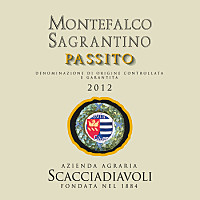
|
|
Montefalco Sagrantino Passito 2012 |
|
| Scacciadiavoli (Umbria, Italy) | |
 SagrantinoMontefalco Sagrantino Passito SagrantinoMontefalco Sagrantino Passito | |
| Price: € 25.00 - 375 ml | Score: |
 Deep ruby red and nuances of garnet red, little transparency. Deep ruby red and nuances of garnet red, little transparency. Intense, clean, pleasing, refined and elegant, starts with hints of
blackberry, plum and dried violet followed by aromas of black cherry,
blueberry, walnut husk, tamarind, chocolate, cinnamon, mace, vanilla and
menthol. Intense, clean, pleasing, refined and elegant, starts with hints of
blackberry, plum and dried violet followed by aromas of black cherry,
blueberry, walnut husk, tamarind, chocolate, cinnamon, mace, vanilla and
menthol.
 Sweet and tannic attack, however balanced by alcohol, full body,
intense flavors, pleasing roundness. Sweet and tannic attack, however balanced by alcohol, full body,
intense flavors, pleasing roundness.
 Persistent finish with flavors of blackberry, plum and black cherry. Persistent finish with flavors of blackberry, plum and black cherry. 24 months in barrique, at least 12 months in bottle. 24 months in barrique, at least 12 months in bottle. |
|
 Wild fruit tarts, Chocolate and cocoa tarts, Hard cheese Wild fruit tarts, Chocolate and cocoa tarts, Hard cheese |
|
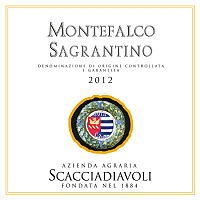
|
|
Montefalco Sagrantino 2012 |
|
| Scacciadiavoli (Umbria, Italy) | |
 Sagrantino Sagrantino | |
| Price: € 20.00 | Score: |
 Intense ruby red and nuances of garnet red, little transparency. Intense ruby red and nuances of garnet red, little transparency. Intense, clean, pleasing, refined and elegant, starts with hints of
blackberry, plum and black cherry followed by aromas of dried violet,
blueberry, tobacco, face powder, chocolate, red orange, vanilla, tamarind
and menthol. Intense, clean, pleasing, refined and elegant, starts with hints of
blackberry, plum and black cherry followed by aromas of dried violet,
blueberry, tobacco, face powder, chocolate, red orange, vanilla, tamarind
and menthol.
 Tannic attack and however balanced by alcohol, full body, intense
flavors, pleasing roundness. Tannic attack and however balanced by alcohol, full body, intense
flavors, pleasing roundness.
 Persistent finish with flavors of blackberry, plum and black cherry. Persistent finish with flavors of blackberry, plum and black cherry. 24 months in barrique and cask, 12 months in bottle. 24 months in barrique and cask, 12 months in bottle. |
|
 Game, Roasted meat, Braised and stewed meat, Hard cheese Game, Roasted meat, Braised and stewed meat, Hard cheese |
|
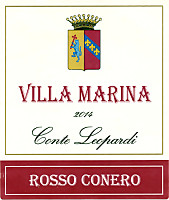
|
|
Rosso Conero Villa Marina 2014 |
|
| Conte Leopardi Dittajuti (Marches, Italy) | |
 Montepulciano Montepulciano | |
| Price: € 9.50 | Score: |
 Intense ruby red and nuances of garnet red, little transparency. Intense ruby red and nuances of garnet red, little transparency. Intense, clean, pleasing and refined, starts with hints of plum, black
cherry and blueberry followed by aromas of violet, blackberry, tobacco,
vanilla and cocoa. Intense, clean, pleasing and refined, starts with hints of plum, black
cherry and blueberry followed by aromas of violet, blackberry, tobacco,
vanilla and cocoa.
 Properly tannic attack and however balanced by alcohol, good body,
intense flavors, pleasing roundness. Properly tannic attack and however balanced by alcohol, good body,
intense flavors, pleasing roundness.
 Persistent finish with flavors of plum, black cherry and blueberry. Persistent finish with flavors of plum, black cherry and blueberry. 8 months in steel tanks, 12 months in barrique. 8 months in steel tanks, 12 months in barrique. |
|
 Stuffed pasta, Broiled meat and barbecue, Roasted meat, Cheese Stuffed pasta, Broiled meat and barbecue, Roasted meat, Cheese |
|
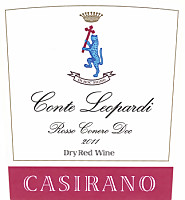
|
|
Rosso Conero Casirano 2011 |
|
| Conte Leopardi Dittajuti (Marches, Italy) | |
 Montepulciano (85%), Syrah (8%), Cabernet Sauvignon (7%) Montepulciano (85%), Syrah (8%), Cabernet Sauvignon (7%) | |
| Price: € 14.50 | Score: |
 Intense ruby red and nuances of garnet red, little transparency. Intense ruby red and nuances of garnet red, little transparency. Intense, clean, pleasing and refined, starts with hints of plum,
blueberry and dried violet followed by aromas of black cherry, blackberry,
black currant, chocolate, vanilla, tobacco and menthol. Intense, clean, pleasing and refined, starts with hints of plum,
blueberry and dried violet followed by aromas of black cherry, blackberry,
black currant, chocolate, vanilla, tobacco and menthol.
 Properly tannic attack and however balanced by alcohol, good body,
intense flavors, pleasing roundness. Properly tannic attack and however balanced by alcohol, good body,
intense flavors, pleasing roundness.
 Persistent finish with flavors of plum, black cherry and blueberry. Persistent finish with flavors of plum, black cherry and blueberry. 12 months in barrique, 10 months in bottle. 12 months in barrique, 10 months in bottle. |
|
 Roasted meat, Stewed meat with mushrooms, Broiled meat and barbecue, Hard cheese Roasted meat, Stewed meat with mushrooms, Broiled meat and barbecue, Hard cheese |
|

|
|
Montecucco Rosso Ciarlone 2014 |
|
| Tenuta L'Impostino (Tuscany, Italy) | |
 Sangiovese (60%), Merlot, Alicante, Petit Verdot (40%) Sangiovese (60%), Merlot, Alicante, Petit Verdot (40%) | |
| Price: € 9.90 | Score: |
 Brilliant ruby red and nuances of garnet red, moderate transparency. Brilliant ruby red and nuances of garnet red, moderate transparency. Intense, clean, pleasing and refined, starts with hints of plum, black
cherry and black currant followed by aromas of blueberry, dried violet,
raspberry, blackberry, geranium and tobacco. Intense, clean, pleasing and refined, starts with hints of plum, black
cherry and black currant followed by aromas of blueberry, dried violet,
raspberry, blackberry, geranium and tobacco.
 Properly tannic attack and however balanced by alcohol, good body,
intense flavors, agreeable. Properly tannic attack and however balanced by alcohol, good body,
intense flavors, agreeable.
 Persistent finish with flavors of plum, black cherry and black currant. Persistent finish with flavors of plum, black cherry and black currant. 12 months in steel tanks, 6 months in bottle. 12 months in steel tanks, 6 months in bottle. |
|
 Stuffed pasta, Broiled meat and barbecue, Sauteed meat, Cheese Stuffed pasta, Broiled meat and barbecue, Sauteed meat, Cheese |
|

|
|
Montecucco Rosso Impostino 2012 |
|
| Tenuta L'Impostino (Tuscany, Italy) | |
 Sangiovese (80%), Merlot, Syrah, Petit Verdot (20%) Sangiovese (80%), Merlot, Syrah, Petit Verdot (20%) | |
| Price: € 11.90 | Score: |
 Brilliant ruby red and nuances of garnet red, moderate transparency. Brilliant ruby red and nuances of garnet red, moderate transparency. Intense, clean, pleasing and refined, starts with hints of plum, black
cherry and dried violet followed by aromas of black currant, blueberry,
tobacco, vanilla, carob, graphite and menthol. Intense, clean, pleasing and refined, starts with hints of plum, black
cherry and dried violet followed by aromas of black currant, blueberry,
tobacco, vanilla, carob, graphite and menthol.
 Properly tannic attack and however balanced by alcohol, good body,
intense flavors, pleasing roundness. Properly tannic attack and however balanced by alcohol, good body,
intense flavors, pleasing roundness.
 Persistent finish with flavors of plum, black cherry and black currant. Persistent finish with flavors of plum, black cherry and black currant. 12 months in cask and cement tanks, 6 months in bottle. 12 months in cask and cement tanks, 6 months in bottle. |
|
 Pasta with meat and mushrooms, Roasted meat, Broiled meat and barbecue Pasta with meat and mushrooms, Roasted meat, Broiled meat and barbecue |
|

|
|
Barolo Gramolere 2013 |
|
| Manzone Giovanni (Piedmont, Italy) | |
 Nebbiolo Nebbiolo | |
| Price: € 33.00 | Score: |
 Brilliant ruby red and nuances of orange red, moderate transparency. Brilliant ruby red and nuances of orange red, moderate transparency. Intense, clean, pleasing, refined and elegant, starts with hints of
cherry, plum and violet followed by aromas of raspberry, blueberry, rose,
tobacco, cocoa, vanilla, leather, licorice, cinnamon, mace and menthol. Intense, clean, pleasing, refined and elegant, starts with hints of
cherry, plum and violet followed by aromas of raspberry, blueberry, rose,
tobacco, cocoa, vanilla, leather, licorice, cinnamon, mace and menthol.
 Tannic attack and however balanced by alcohol, full body, intense
flavors, pleasing crispness. Tannic attack and however balanced by alcohol, full body, intense
flavors, pleasing crispness.
 Persistent finish with flavors of cherry, plum and raspberry. Persistent finish with flavors of cherry, plum and raspberry. 30 months in cask. 30 months in cask. |
|
 Game, Roasted meat, Stewed and braised meat, Hard cheese Game, Roasted meat, Stewed and braised meat, Hard cheese |
|

|
|
Barolo Riserva Gramolere 2011 |
|
| Manzone Giovanni (Piedmont, Italy) | |
 Nebbiolo Nebbiolo | |
| Price: € 56.00 | Score: |
 Brilliant ruby red and nuances of garnet red, little transparency. Brilliant ruby red and nuances of garnet red, little transparency. Intense, clean, pleasing, refined and elegant, starts with hints of
cherry, plum and violet followed by aromas of raspberry, rose, strawberry,
tobacco, cocoa, face powder, cinnamon, vanilla, mace, leather, licorice and
menthol. Intense, clean, pleasing, refined and elegant, starts with hints of
cherry, plum and violet followed by aromas of raspberry, rose, strawberry,
tobacco, cocoa, face powder, cinnamon, vanilla, mace, leather, licorice and
menthol.
 Tannic attack and however balanced by alcohol, full body, intense
flavors, pleasing crispness. Tannic attack and however balanced by alcohol, full body, intense
flavors, pleasing crispness.
 Very persistent finish with long flavors of cherry, plum and raspberry. Very persistent finish with long flavors of cherry, plum and raspberry. 48 months in cask, 12 months in bottle. 48 months in cask, 12 months in bottle. |
|
 Game, Stewed and braised meat, Roasted meat, Hard cheese Game, Stewed and braised meat, Roasted meat, Hard cheese |
|
News |
|
In this section are published news and information about events concerning the world of wine and food. Whoever is interested in publishing this kind of information can send us a mail to our address.
|
AquavitaeReview of Grappa, Distillates and Brandy |
|
|
||||||||||||||
Wine Guide ParadeFebruary 2018
|
| |||||||
Privacy Policy | |||||||


| Copyright © 2002-2024 Antonello Biancalana, DiWineTaste - All rights reserved |
| All rights reserved under international copyright conventions. No part of this publication and of this WEB site may be
reproduced or utilized in any form or by any means, electronic or mechanical, without permission in writing from DiWineTaste. |